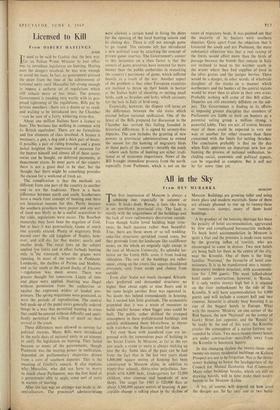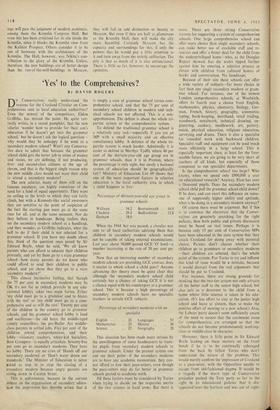All in the Sky
From DEV rTHE first impression of Moscow is always a I subduing one, especially in autumn or winter. It looks drab. Worse, it feels like being in an overblown provincial city. The fault is mostly with the ungainliness of the buildings and the lack of even rudimentary decoration outside. Even though Stalin loved building huge struc- tures, he built massive rather than beautiful. True, there are those seven or so tall wedding- cake-like structures sprinkled round town, but they protrude from the landscape like cauliflower noses, on the whole an ungainly sight except in the case of Moscow University. Its splendid iso- lation on the Lenin Hills saves it from looking ridiculous. The rest of the buildings are rather squat, sitting op the streets like square-shouldered overcoats, cosy from inside and clumsy from outside.
Even after Stalin not much changed. Khrush- chev preferred and demanded structures no higher than about eight or nine floors and in the same height another floor was squeezed in. No doubt this helped tremendously in housing, but it earned him little gratitude. The economists grumbled that it was a waste of resources to build smaller houses when bigger ones could be built. The public rather disliked the cramped atmosphere in these prefabricated buildings and quickly nicknamed them khruscheva, to rhyme with truschova, the Russian word for slum.
Yet even those with jaundiced eyes are im- pressed with the tremendous pace of building in the Soviet Union. In Moscow, as far as the eye can reach, a crane or more is always sticking up into the sky. Some idea of the pace can be had from the fact that in the last two years alone 6,800,000 square metres of housing has been constructed in Moscow alone, in addition to ninety-five schools, thirty-nine polyclinics, hos- pitals with 6,000 beds, kindergartens for 52,000 children, nine cinemas and hundreds of new shops. The target for 1965 is 120,000 flats or about 3,500,000 square metres of housing. A per- ceptible change is taking place in the skyline of Moscow. Buildings are growing taller and using more glass and modern materials. Some of them are already planned to rise up to twenty-three or twenty-six storeys, many of them hotel buildings.
A by-product of the housing shortage has been the paucity of hotel accommodation, aggravated by slow and complicated bureaucratic methods. To book hotel accommodation in Moscow is quite a feat and the pressure is made even worse by the growing influx of tourists, who are encouraged to come in droves. two new hotels are being built for them in the centre of the city, near the Kremlin. One of them is the long- familiar 'National,' the favourite of hotel con- noisseurs. It is to be, transformed into a twenty- three-storey modern structure, with accommoda- tion for 1,500 guests. The most talked-about hotel under construction, however, is `Rossia.' It is only twelve storeys high but it is situated on the river embankment by the side of the Kremlin. It will have accommodation for 6,000 guests and will include a concert hall and two cinemas. Intourist is already busy boosting it as one of the biggest hotels in Europe. What with the massive 'Moskva' on One corner of the Red Square, the new 'National' on the corner of Gorky Street just opposite, and the 'Rossia' to he ready by the end of this year, the Kremlin creates the atmosphere of a native fortress sur- rounded by aliens. Two more twenty-storey hotels are under construction—mercifully away from the Kremlin in Smolensk Square.
In this changing skyline the twenty-three- and twenty-six-storey residential buildings on Kalinin Prospect are not to be forgotten. Nor is the thirty- storey building to house the headquarters of the Council for Mutual Economic Aid (Comecon). Many other buildings besides, which are still on drawing boards, will in time make their contri- bution to the Moscow skyline.
A lot, of course, will depend on how good the designs are. So far only one or two build- ings will pass the judgment of modern architects, among them the Kremlin Congress Hall. But even this has been criticised for its site inside the Kremlin, since it blocks the Kremlin view from the Kalinin Prospect. Others consider it to be out of harmony with the architecture of the Kremlin. The Hall, however, was Nikita's con- tribution to the glory of the Kremlin. Unless, therefore, the new buildings are of better design than the run-of-the-mill-buildings in Moscow, they will fail to add distinction or beauty to Moscow. But even if they are half as glamorous as the Kremlin Hall, they will make the city more beautiful. Certainly Moscow has the capacity and surroundings for this, if only the powers that be would pay a little attention to it and turn away from the strictly utilitarian. The pity is that so much of it is also unfunctional. There is little so far, however, to encourage the optimists.



































 Previous page
Previous page